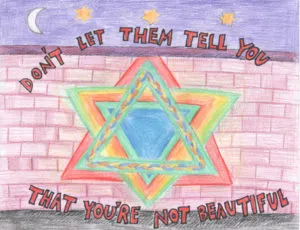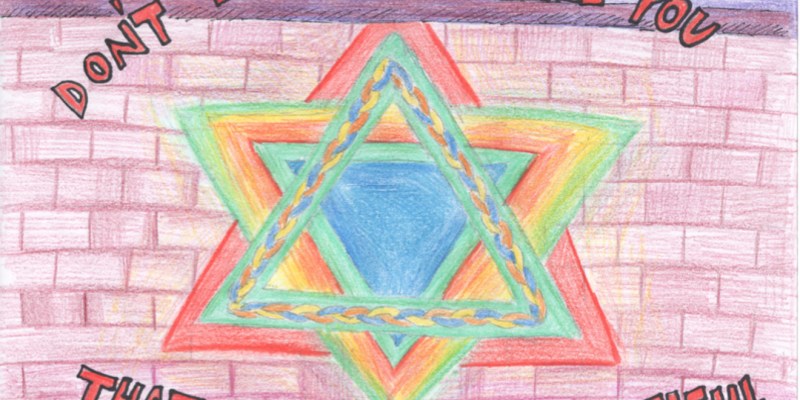Stanford’s Jewish community has reacted with a wide range of emotions and opinions to anti-Semitic vandalism defacing campus over the past couple of months, as well as to the University’s and student body’s responses to the crimes.
Over winter break, incorrectly drawn swastikas appeared on buildings and street signs around Stanford. The words “no Jews allowed” were graffitied next to some of the swastikas. Between Jan. 20 and 22, more swastika-like symbols were discovered in Escondido Village.
“Some people feel very strongly that again there should be a rally, [that] the University should come out and make statements about [the graffiti], and then you know for some people it’s just not as big of a deal,” said David Kahn ’17, president of the Jewish Student Association (JSA). “People are preoccupied with so many other things that I think it’s gotten swept under the rug.”
Many members of the Jewish community first heard about the vandalism through local news articles such as a Mercury News piece published on Jan. 3. Some saw articles shared by friends on Facebook.
Stanford President Marc Tessier-Lavigne addressed the vandalism in a statement that appeared in Stanford News on Jan. 5. The statement was also included in a Jan. 13 newsletter email from Hillel@Stanford, a non-profit organization founded at Stanford 50 years ago as a resource for Jewish students.
“It is profoundly troubling to learn that vandals have defaced both the Stanford campus and Palo Alto with symbols of hate,” Tessier-Lavigne said in the statement. “The University does not tolerate hate crimes, and our campus police are conducting a full investigation together with the Palo Alto police department. We have zero tolerance for such appalling acts. Stanford is a community that embraces civil discourse, where we value our differences and treat one another with respect.”
On Jan. 25, a campus-wide community alert email notified recipients of the graffiti, citing “17 incidents of vandalism of a similar nature” since Dec. 30. The email also described a cyber-attack in which hackers sent flyers with swastikas and hate speech to office printers around campus.
“Although the symbols were drawn facing the opposite direction from the Nazi swastika, it is believed the drawings are intended to connote anti-Semitism,” the alert read.
According to SUDPS spokesperson Bill Larson, investigations by the Stanford University Department of Public Safety (SUDPS) have found no leads.
For many community members, it was jarring to hear news of swastikas and the words “no Jews allowed” dotted across campus through outside news sources or through Stanford’s community alert email system instead of through a more personal letter addressed from an administrator.
According to to Lisa Lapin, vice president for university communications, the University was not alerted about the swastikas until Jan. 4.
“Stanford takes acts of hate seriously, and they have no place at Stanford,” Lapin said in an email to The Daily.
Tessier-Lavigne brought up the vandalism again at a Faculty Senate meeting on Jan. 26, reaffirming the University’s commitment to supporting the Jewish community and other vulnerable communities at Stanford.
The swastikas from the past couple months do not mark the first time Stanford’s campus has been vandalized with anti-Semitic messages. In April 2015, swastikas were painted on student residences on the Row. Similar incidents took place in 1988.
“The first time there were swastikas I was a sophomore and I had a strong reaction,” Kahn said. “But now I’ve sort of become a little desensitized.”
On Jan. 27, Hillel@Stanford held a meeting for students and staff to discuss ideas and feelings centered around the vandalism as well as other instances of hatred. In the context of the vandalism, security at the Hillel buildings is being updated this quarter.
Some students would have liked more direct acknowledgement and support from the University in light of the graffiti.
“I think the University generally does a good job standing up for students and I felt like this warranted a more timely and more serious response,” said Jacob Kaplan-Lipkin ’19, co-president of the Stanford Israel Association (SIA). “Does the fact that it’s happened so much and that we’re desensitized mean that we shouldn’t respond? No, definitely not, I think that’s a very poor way of conducting our responses to things … But I do understand that practically there are only so many times you can issue a condemnation.”
Others were concerned that the administration’s response unnecessarily avoided references to the anti-Semitic nature of the incidents.
“I feel like [the administration] needs to make a statement that makes it clear that they’re talking about helping and supporting their Jewish students, and not just avoiding saying the word Jewish or anti-Semitism as their first statement did,” said Jacob Reiter ’20, a member of Jewish Freshman Council, or JewFro, and of SIA. Reiter, a Daily staffer, felt that the “no Jews allowed” part of the graffiti warranted mentioning in statements.
“I feel like it’s part of a larger problem with Stanford and ignorance towards anti-Semitism,” Reiter said.

Rabbi Serena Eisenberg, executive director of Hillel@Stanford, believes that the University can take steps to create more awareness around Jewish community concerns.
“We appreciate that the new president, Marc Tessier-Lavigne, spoke out immediately about the hate crimes,” Eisenberg said. “But I also think it’s important that the University take certain actions to better meet the needs of Jewish students on campus.”
Eisenberg suggested strengthening the kosher dining program and including Hillel@Stanford as a community center like the Markaz, the Black Community Center and the Women’s Community Center.
“Stanford is a diverse, inclusive, flourishing campus for Jewish life and for Jewish students,” Eisenberg added.
Some expressed doubt that the graffiti reflects a campus issue; others questioned what concrete action the University could take, especially if the crimes were committed by an individual outside of Stanford, as was the case in 2015.
“The University made a statement; they said they didn’t have any tolerance for this kind of thing,” said Julia Daniel ‘17, board member of JSA. “I think the response that they’ve given is okay.”
Daniel sees student response to the vandalism as a separate issue. She would have liked to see more attention paid to the vandalism among the broader student community. Others were also disappointed with the greater student body’s perceived lack of awareness about the issue and felt that almost no students outside of the Jewish community knew about the vandalism.
“I think in every discussion that I’ve had, there has been a question about the greater student communal response, which has been pretty much silence or ignorance,” said Michal Leibowitz ’19, president of SIA and one of the outreach chairs of JSA. “And there’s certainly a feeling of being alone as a Jewish community on campus and not necessarily enclosed in the fold of solidarity that sometimes is shown among different student minority groups.”
Leibowitz and Reiter were both disturbed that the People’s Walkout, a campus demonstration held on Nov. 15 in response to President Donald Trump’s election, initially did not include Jews on its list of minorities. After Reiter reached out to the organizers, they added the Jewish community to their event description.
“As a Jewish community, we could work on our outreach and educational efforts, and I think that in response, the student body could ask questions and take it upon themselves to learn more,” Leibowitz said.
Daniel emphasized the importance of integrating the fight against anti-Semitism into the struggle against other forms of oppression without conflating the two.
“It’s important for us to remember that anti-Semitism doesn’t look like Islamophobia looks right now in this country; anti-Semitism doesn’t look like anti-blackness looks like in this country,” Daniel said. “There are so many issues going on right now. I wouldn’t want anti-Semitism to take away from these other causes; I want it to add to the variety of other issues people are working against.”
Rabbi Patricia Karlin-Neumann, senior associate dean for religious life, believes that the turbulent national political situation, as well as the new University administration, played a role in forming campus responses to the graffiti. Even under normal circumstances, she said, this event would be difficult to address.
“I think that there’s such a blizzard of things coming at the students and coming at the University, a kind of paroxysm of hatred that we’re seeing in our civic culture,” Karlin-Neumann said. “I think it’s hard for people to focus on one and respond to one … So I don’t think it’s an absence of compassion or an absence of concern.”
She explained that the Jewish community’s fear and disorientation is increasing in the face of a growing number of anti-Semitic incidents across the United States. Over the past two months, 54 Jewish Community Centers in 27 states have received bomb threats in 69 incidents.
Karlin-Neumann hopes that the Jewish community will channel their experiences into action on behalf of other minorities.
“I don’t want to get into comparative suffering, but I would hope that the experience of feeling that disorientation and that concern and fear would in fact lead to a kind of empathetic response of appreciation of what other communities are experiencing,” she said. “And I see that in many places.”
The University can recognize the experiences of other communities without detracting from its response to anti-Semitism on campus, said Kaplan-Lipkin, who commended the University for joining an amicus brief against Trump’s executive order targeting immigration from seven majority-Muslim countries.
Daniel emphasized that the Jewish community does not have a unified stance on the vandalism.
“I hope that people on campus understand that within the Jewish community, just as within any other community, there are so many different opinions and feelings about how we should be reacting in this moment,” Daniel said. “What we should be thinking about, how worried we should even be, is anti-Semitism even relevant anymore. There’s such a variety of opinions across the board on that.”
Later, though, Daniel added in an email to The Stanford Daily that recent events such as bomb threats, cemetery defacements and a gunshot fired through a synagogue window have “made it particularly clear that the conversation is changing in our community.”
“I think the range of opinions that existed six months or a year ago, about how much of a problem and how relevant anti-Semitism is, is narrowing quickly,” she said.
Acts of intolerance can be reported at Student Affairs’ website.
Contact Elise Most at emost ‘at’ stanford.edu.
This article has been updated to reflect additional comments from Daniel.
